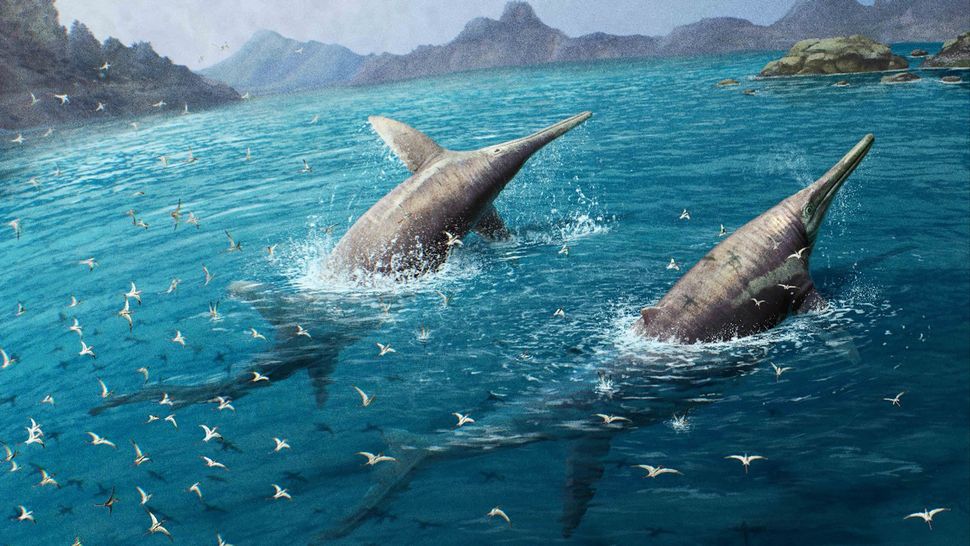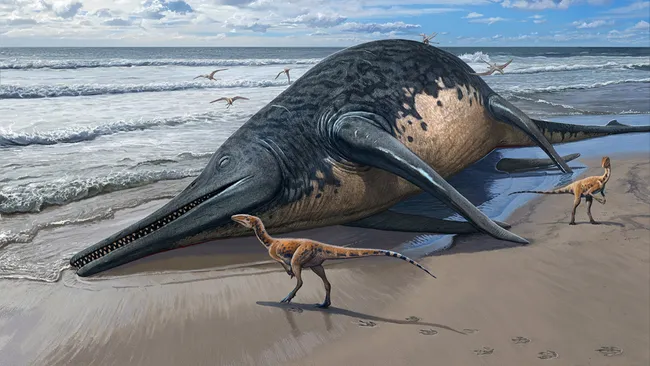Scientists have made a remarkable discovery: the fossilized remains of a colossal sea creature dating back 200 million years. This newly found behemoth, a member of the ichthyosaur group, is believed to be the largest marine reptile ever identified.
During the Mesozoic era, ichthyosaurs reigned as apex predators of the seas. The newfound species lived at the tail end of the Triassic period, a time marked by the emergence of exceptionally large ichthyosaurs.
Despite the Mesozoic era’s association with dinosaurs, ichthyosaurs were a distinct group of marine reptiles, evolving from terrestrial ancestors much like whales did from land mammals. Like their cetacean counterparts, ichthyosaurs breathed air and birthed live offspring.
Fragments of the newfound ichthyosaur were discovered between 2020 and 2022 at Blue Anchor, Somerset, in the United Kingdom. Initially spotted atop a beach rock by a passerby, these fossilized remains were later studied by researchers, culminating in a recent publication in the journal PLOS One.
The identified fragments, comprising 12 pieces from a surangular bone found in the upper jaw’s lower section, suggest a creature of immense proportions. Estimates indicate the bone measured 6.5 feet (2 meters) long, indicating an astounding total length of approximately 82 feet (25 meters) for the living animal.
Named Ichthyotitan severnensis, meaning “giant lizard fish of the Severn,” after the location of its discovery, this sea monster represents not only a new species but also an entirely new genus of ichthyosaur. This find adds to the over 100 known species of these fascinating marine reptiles.

Additional discoveries in the area included rib fragments and a coprolite, although these were not definitively linked to the same creature. The sedimentary layers housing these specimens also contained evidence of seismic activity, suggesting the region experienced earthquakes and tsunamis, possibly indicating a period of intense volcanic activity that could have contributed to a significant extinction event at the Triassic’s conclusion, as proposed by the researchers.
A comparable find was made in Lilstock, Somerset, in 2016 and detailed in 2018. Both specimens were unearthed within the Westbury Mudstone Formation, approximately 6 miles (10 kilometers) apart. While the Lilstock ichthyosaur was estimated to reach lengths of up to 85 feet (26 meters), the authors of the recent study believe it may have been slightly smaller.
Previously, the largest known marine reptile was Shonisaurus sikanniensis, another ichthyosaur measuring up to 69 feet (21 meters) long. However, this species appeared 13 million years prior to Ichthyotitan severnensis and was discovered in British Columbia, making it improbable that the newly found specimen is a member of the same species.
Another substantial ichthyosaur, Himalayasaurus tibetensis, potentially reaching lengths of 49 feet (15 meters), was found in Tibet and described in 1972. Despite dating to the same period, it is unlikely to be the same species as the recent discovery.
The researchers suggest Ichthyotitan severnensis was among the final giants of the ichthyosaurs. These creatures persisted into the late Cretaceous period, eventually yielding to the dominance of plesiosaurs—elongated marine reptiles that, along with all non-avian dinosaurs, faced extinction at the Cretaceous-Paleogene boundary.
